Ama Divers and Artists
This series of exhibitions consisting of works by six Japanese and Australian artists is being held simultaneously in the town of Ijikacho, Toba in Mie Prefecture and the neighborhood of Jimbocho in Tokyo. The shows are inspired by culture representative of each town: “contemporary ama diver culture” and “artistic cultural Ukiyo-e assets.” Linda Dennis, an artist and educator based in Toba and Tokyo, and Mai Ishihara, of the Toba Sea-Folk Museum, co-directed the project with the intention of creating “an opportunity for artists to come into direct contact with the ama divers of Ijikacho” and “a place where the world can come into contact with ama culture.” In March of last year, the participating artists conducted preliminary research and production in Ijikacho, and even after the spread of COVID-19 made direct communication difficult, preparations for the exhibition were made while being mindful of the Ukiyo-e artists who drew pictures based on documents rather than meeting the ama in person. In Ijikacho, site-specific works were unveiled in various places, including Japanese hotels and outdoor areas, starting from July 18 last year, and in Jimbocho, the exhibition started on March 16 this year inside long-established bookstores and galleries that stock Ukiyo-e.
At Gallery Soumei-do on the 7th floor of Yamada Building in Jimbocho, you can see the works of all the participating artists. The “colorful” works (watercolors, acrylics, gouache, and digital prints on paper) that respond to the vivid colors of the multi-colored woodblock prints of Ukiyo-e are captivating. However, once one confronts the individual works, one realizes that their interpretation of Ukiyo-e is not singular. No two depictions of ama divers are the same. This may be said to be an accurate reflection of the unique existence of the “ama” divers who cannot be captured by a single definition, and the freedom and resilience of the “artist” who is not bound by a single view, even though they are each viewed in different ways at different times.
For example, the two works referring to Chikanobu Hashimoto’s “Sokai Awabitori no Zu” are very different. Miyuki Inagaki and Aiko Ono similarly focus on the complex plurality of the images of ama divers depicted by Hashimoto, such as being on land and in the sea, and being clothed and naked. Yet, while Inagaki develops these themes into a painterly subject of figuration and abstraction, mysteriously depicting the divers between land and sea, Ono, drawing on her own experience as a diver, converts the depiction of half-naked divers (which can be the object of a sexual gaze in a contemporary context) into the narrative of a “half-fish person.”
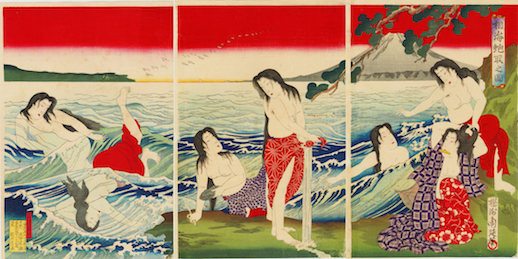
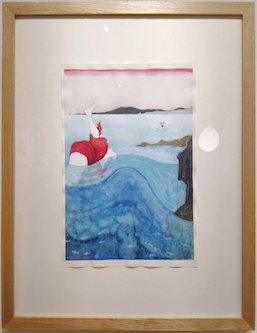
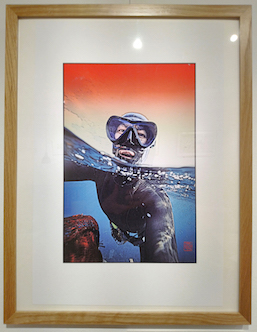
The colorful works also include a delicate gradation of monotone. Linda Dennis’s work embossed with a sukari (a kind of net bag used by ama divers), labeled together with the name of the owner of the bag, gives the viewer a certain tactile sensation as if he or she were directly exposed to ama culture of Ijikacho. At the same time, it also shows the connection with the development of sculptural works using nets, which are the center of Dennis’s recent works (and which can be seen in Ijikacho).
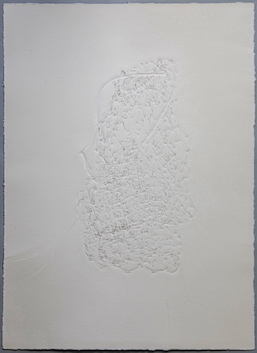
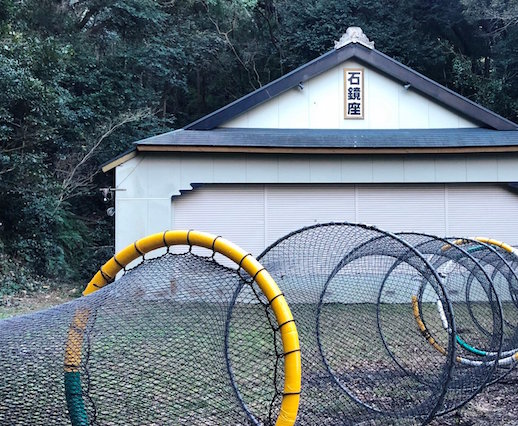
At 50-Gallery on the 5th floor of the same building, there is an exhibition of works referring to Kuniyoshi Utagawa’s “Ensekizasshi,” which is characterized by its delicate expression (waves embossed with mica and soft colors of natural origin) in spite of its bewitching theme. Zoe Porter’s work references this in a creative interpretation, she colorfully adapts Utagawa’s image into the open and imaginative imagery that is characteristic of her work. In this work, the patternization of natural phenomena characteristic of Ukiyo-e is further emphasized, reminiscent of the “tradition” of Australian culture (Aboriginal culture). In the exhibition in the Yamada Shoten Art Section on the second floor of the same building, Yuna Ogino, like Porter, draws on her own theme of “flowers and the body” and her aesthetic sense to create a contemporary painting with thick brushstrokes, as if to give flesh to the body of the diver, which was flattened in the Ukiyo-e “Mitsuuji Isobeasobi no Zu” by Toyokuni Utagawa.
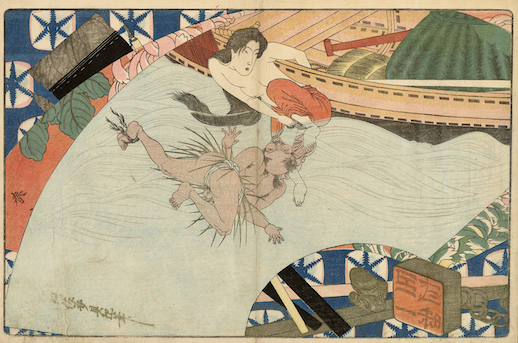
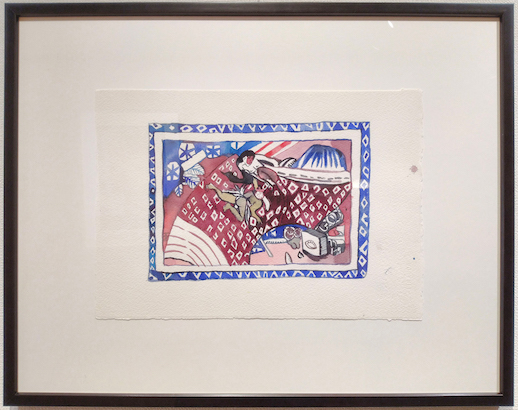
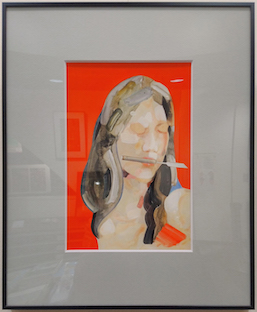
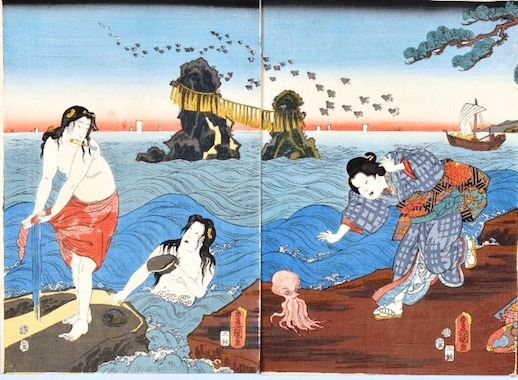
Meiko Kitamura, the youngest participant in the exhibition, reimagined Yoshitora Utagawa’s “Sankai Yuran no Uchi Hikaru-kimi Awabitori no zu” by projecting her own image of a lonely artist and her actual experience of going out to sea with the ama divers of Ijikacho onto the image of the ama through radical allegorizing. In contrast to a leap of imagination in Kitamura’s creation, Dennis’s exhibition at Ohya Shobo shows traces of her honest confrontation with the cultural significance of her subject as well as the richness of its texture and form through her first time expressing herself using printmaking. Inagaki’s works exhibited at Hara Shobo also trace the artist’s journey toward her own abstract expression, while taking on the worldview and compositions characteristic of Ukiyo-e.
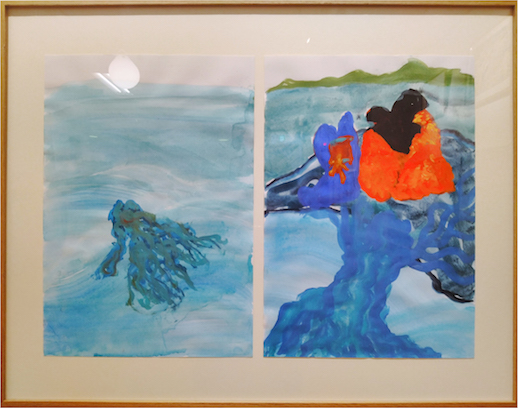
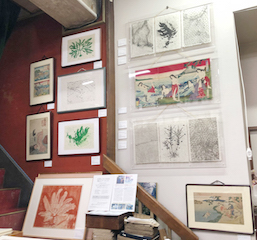
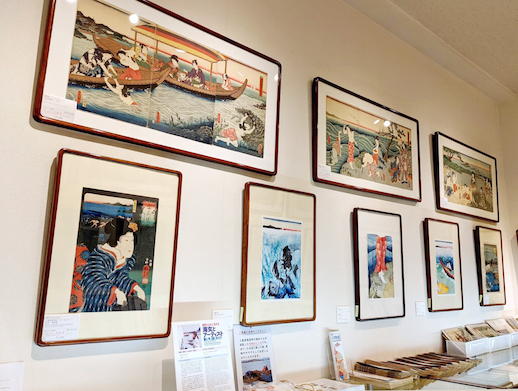
The organizers and participating artists flexibly, boldly, and patiently sustained their research, production, and exhibition activities. This in itself seems to symbolize the characteristics that are common to both divers and artists. In other words, the culture of ama, which is said to have lasted for more than 3,000 years, and the artistic practice that has existed since prehistoric times, have been sustained through a common intertwining of techniques that fuse intelligence and sensitivity, the philosophy of coexistence with nature, and the element of a small community in which individuals can thrive. In addition, the fact that this exhibition has been realized through the handiwork of independent and creative women is not unrelated to the theme “Touch,” which Dennis, the curator, has been pursuing for many years. This theme could be described as an attempt to “draw in” today’s issues such as tolerance of diversity in society, connection between urban and rural areas, and international collaboration. Please visit the exhibition and experience the works for yourself.
For more information about the exhibitions in each area, please visit the following links. The exhibition will be held until March 31 at all locations.
https://touch-base-create.net/amadivers-and-artists/
https://www.facebook.com/amadivers.and.artists/
Writer: Utako Shindo (Artist. She pursues the “poetics of untranslatability” through her artistic and scholarly activities internationally.)
Edited by Jennifer Pastore
Japanese Version:
とらえられない/とらわれない海女とアーティスト——「自然とともに生きる 海女とアーティスト 昔と今。石鏡町と神保町にダイブ!」展レビュー
鳥羽の石鏡町と東京の神保町を繋いで同時開催されている本展は、それぞれの町が象徴する「現代に生きる海女文化」と、伝統的な海女像を描いた「浮世絵という文化芸術」 から着想を得た、日本とオーストラリアの表現者6名が思い思いに制作した作品から構成される。鳥羽と東京を拠点とする美術家で教育者のリンダ・デニスと、鳥羽市立海の博物館の石原真伊とが共同企画した背景には、「アーティストが石鏡の海女と直接触れ合う機会」と「世界が海女文化にタッチできる場」を創出するという意図があるという。昨年3月に石鏡町で参加作家による事前リサーチと制作が実施され、新型コロナウィルス感染症拡大で直接的な交流が困難となった以降も、直に海女に会うのではなく資料をもとに描いた浮世絵師たちに思いを馳せながら、展示開催にむけた準備が進められた。そして、石鏡町では昨年7月18日から町の宿泊施設内や屋外を中心としたサイトスペシフィックな作品が各所でお披露目され、神保町では今年の3月16日から浮世絵を扱う老舗書店やギャラリーの一角で展示がスタートした。
筆者が実際に訪ねた神保町での展示は計5店舗で展開されている。山田ビル7階のギャラリーそうめい堂では、参加作家全員の作品が一望できる。多色刷りの木版の色鮮やかな浮世絵に呼応する、「色とりどり」の作品群(紙を支持体とした水彩、アクリル、ガッシュ、またはデジタルプリント)に目が奪われる。だがひとたび個々の作品と向き合うと、彼女らの浮世絵の解釈が一様でないことに気づく。一つとして同じ海女の描写はない。それは、時代毎に様々な視線を受けつつも、一つの定義では「とらえられない海女」という独特の存在と、一つの見方に「とらわれないアーティスト」の在り様の、自由さと逞しさを、正確に映していると言えるかもしれない。
例えば周延の《相海鮑取之図》を参照した二つの作品は対象的である。稲垣美侑と大野愛子はともに、周延の描く海女像がもつ陸と海、着衣と裸体といった複層性に着目しつつも、稲垣はそれを具象と抽象といった絵画的問題に展開し、陸と海の間に飛び込む海女の姿として神秘的に描き出す。他方、大野愛子は現代では性的な視線の対象にもなり得る半裸の海女像の重層性を、海女である自身の経験に引き寄せながら、人と魚を結ぶ存在(半魚人)として物語的に昇華している。
また、「色とりどり」の中にはモノトーンの繊細なグラデーションも含まれる。リンダ・デニスのスカリ(海女が使う網の一種)をエンボスした作品は、網の所有者名の表記も相まって、石鏡町で直に海女文化に触れたかのような確かな触感を観る者に与える。同時に、デニスの近作の中心である網を用いた彫刻的な作品の展開(石鏡町にて鑑賞できる)との関連も示している。
同ビル5階の五拾画廊では、妖艶なテーマ性に反して繊細な表現(雲母を施したエンボスによる波の表現と自然由来の柔らかな色味)が特徴的な歌川国芳の《艶勢喜雑志》を参照したゾイ・ポーターの作品がある。彼女は創造的な解釈を経由させることで、国芳を、彼女の作品の特徴である開放的かつ想像的なイメージへと色鮮やかに翻案する。そこでは浮世絵特有の自然現象の模様化が一層強調され、オーストラリア文化の「伝統」(アボリジナル文化)をも想起させる。同ビル2階の山田書店美術部の展示では、ポーター同様に、荻野夕奈は「花と身体」という自身のテーマと美意識に引き寄せた解釈をみせており、浮世絵((三代) 歌川豊国《光氏磯辺遊の図》 )に平面化された海女の身体に再び肉感を与えるかの如く、太い筆跡で現代的に絵画化している。
最年少参加の北村芽子は、実際に石鏡町の海女と共に海に出た経験と自らの孤独なアーティスト像を、ラディカルな寓話化を通して海女像に投影し、歌川芳虎の《山海遊覧之内 光君鮑取之図》を塗り替える。北村の飛躍的な創作とは対象的に、大屋書房でのデニスの展示からは、自身初となる版画表現を通して、対象の質感や造形の豊かさとともに、その文化的意義にも実直に向き合った痕跡が読み取れる。また原書房で展示されている稲垣の作品からも、浮世絵の世界観や特徴的な構図を引き受けつつ、独自の抽象表現へと向かう作家の足取りを追うことができる。
本展の企画者そして参加作家たちはコロナ前後を跨ぐ形で、柔軟かつ大胆に、そして忍耐強くリサーチと制作・展示活動を持続させた。それ自体が海女とアーティストの両者に通じる特徴を象徴しているようだ。つまり、3000年以上続くとされる海女文化と有史以前から存在する芸術的営為は、共通して、知性と感性が融合した技術と、自然との共生という哲学、そして個が生かされる小さな共同体という要素が絡み合う形で継続されてきたと言えないだろうか。加えて本展に限って言えば、それが自立的で独創的な女性たちの手仕事によって実現されていることは、キュレーション担当のデニスが長年追い続けているテーマ「Touch(ふれる)」と無関係ではない。このテーマは、社会における多様性への寛容さ、都市と地方との接続、国際的な協働といった今日的な課題を自らの手で「手繰り寄せる」試みと言えるかもしれない。ぜひ、実際に現地に足を運び作品に接していただきたい。
各地の展覧会の詳細情報は以下から。開催は全所で3月31日まで。
https://touch-base-create.net/amadivers-and-artists/
https://www.facebook.com/amadivers.and.artists/
執筆者:進藤詩子(美術家。制作と研究を両輪とした国際的な活動を通して「翻訳不可能性の詩学」を追求している。)
(画像は英語版に掲載がありますので、そちらをご参照ください。以下、画像情報(掲載順))
1. 周延《相海鮑取之図》明治15年(1882年)
2. 稲垣美侑《海女ノ潜水》2021年、水彩、アルシュ紙
3. 大野愛子《もうじき半魚人》2021年、写真、ファインアートマット紙
4. リンダ・デニス《海女のこんせき:スカリ3(エンボス) 》2021年、海女河村つねこが使用していたスカリを紙にエンボス
5. リンダ・デニス《ON TOUCH: CATCH (IJIKACHO)》2020年、漁網、ビニールテープ、塩化ビニルパイプ、ロープ (石鏡町の石鏡座での展示風景)
6. 歌川国芳《艶勢喜雑志》天保3年(1833年)
7. ゾイ・ポーター《海女と妖怪 》2020年、水彩、ガッシュ
8. 荻野夕奈《D-270221_1》2021年、アクリル、紙
9. (三代) 歌川豊国《光氏磯辺遊の図》安政4年(1857年)
10. 北村芽子《二部作 ワカメ姫と遊覧》2022年、アクリル、画用紙
11. リンダ・デニスによる作品および関連する浮世絵の展示風景(大屋書房)
12. 稲垣美侑による作品および関連する浮世絵の展示風景(原書房)



